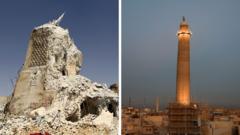The iconic city of Mosul, once ravaged by the extremist group Islamic State (IS), is witnessing a remarkable rebirth as its historic landmarks, churches, and mosques reopen for the first time since the widespread devastation began in 2014. The ambitious restoration project, spearheaded by Unesco, commenced just a year after IS was ousted from the city in 2017.
A ceremony to celebrate the reopening of Mosul's historic sites will be attended by Unesco director-general Audrey Azoulay and Iraqi Prime Minister Mohammed Shia' al-Sudani, along with local artisans and representatives of various religious communities. Mosul was once a beacon of co-existence, but during IS’s reign, it faced horrific violence, with minorities targeted and communities fractured.
After the intense battles to reclaim the Old City of Mosul, photographer Ali al-Baroodi shared chilling memories of his city's transformation, describing a surreal landscape filled with destruction. He recalls the heartbreaking sight of the famous al-Hadba minaret, a symbol of Mosul's history, reduced to ruins, contributing to a landscape that felt unrecognizable to its long-time residents.
In the wake of this extensive damage, approximately 80% of the Old City lay in ruins, necessitating not just structural repairs but also a revival of the bonds among its diverse populations. Unesco's recovery efforts, backed by a $115 million budget primarily from the United Arab Emirates and the European Union, focus on rebuilding both physical and communal infrastructures.
Father Olivier Poquillon, overseeing the restoration of the historic convent of Notre-Dame de l'Heure, emphasized the importance of rebuilding trust among the communities, as a prerequisite for any physical reconstruction. He believes that without the repair of relationships, restored buildings may simply invite conflict anew.
Head of the restoration project, architect Maria Rita Acetoso, underscored the initiative's dual purpose of revitalizing jobs and reaffirming cultural identity amid ongoing regional struggles. Over 1,300 local youths trained in traditional craftsmanship have brought their families closer to their heritage.
Signs of revitalization are evident, as essential landmarks like the al-Tahera Church have been restored, with bells ringing once again. Residents like Mustafa, who returned to their rebuilt homes, expressed profound joy and nostalgia at witnessing the revival of their cherished neighborhoods.
Despite the lingering scars of conflict, the restoration of Mosul's historic sites offers a glimmer of hope for a brighter future. Ali al-Baroodi eloquently likened the city's resurgence to witnessing life returning to a once-dormant entity—an optimism that resonates throughout Mosul, hinting at renewed unity among its rich tapestry of cultures and traditions.
A ceremony to celebrate the reopening of Mosul's historic sites will be attended by Unesco director-general Audrey Azoulay and Iraqi Prime Minister Mohammed Shia' al-Sudani, along with local artisans and representatives of various religious communities. Mosul was once a beacon of co-existence, but during IS’s reign, it faced horrific violence, with minorities targeted and communities fractured.
After the intense battles to reclaim the Old City of Mosul, photographer Ali al-Baroodi shared chilling memories of his city's transformation, describing a surreal landscape filled with destruction. He recalls the heartbreaking sight of the famous al-Hadba minaret, a symbol of Mosul's history, reduced to ruins, contributing to a landscape that felt unrecognizable to its long-time residents.
In the wake of this extensive damage, approximately 80% of the Old City lay in ruins, necessitating not just structural repairs but also a revival of the bonds among its diverse populations. Unesco's recovery efforts, backed by a $115 million budget primarily from the United Arab Emirates and the European Union, focus on rebuilding both physical and communal infrastructures.
Father Olivier Poquillon, overseeing the restoration of the historic convent of Notre-Dame de l'Heure, emphasized the importance of rebuilding trust among the communities, as a prerequisite for any physical reconstruction. He believes that without the repair of relationships, restored buildings may simply invite conflict anew.
Head of the restoration project, architect Maria Rita Acetoso, underscored the initiative's dual purpose of revitalizing jobs and reaffirming cultural identity amid ongoing regional struggles. Over 1,300 local youths trained in traditional craftsmanship have brought their families closer to their heritage.
Signs of revitalization are evident, as essential landmarks like the al-Tahera Church have been restored, with bells ringing once again. Residents like Mustafa, who returned to their rebuilt homes, expressed profound joy and nostalgia at witnessing the revival of their cherished neighborhoods.
Despite the lingering scars of conflict, the restoration of Mosul's historic sites offers a glimmer of hope for a brighter future. Ali al-Baroodi eloquently likened the city's resurgence to witnessing life returning to a once-dormant entity—an optimism that resonates throughout Mosul, hinting at renewed unity among its rich tapestry of cultures and traditions.




















